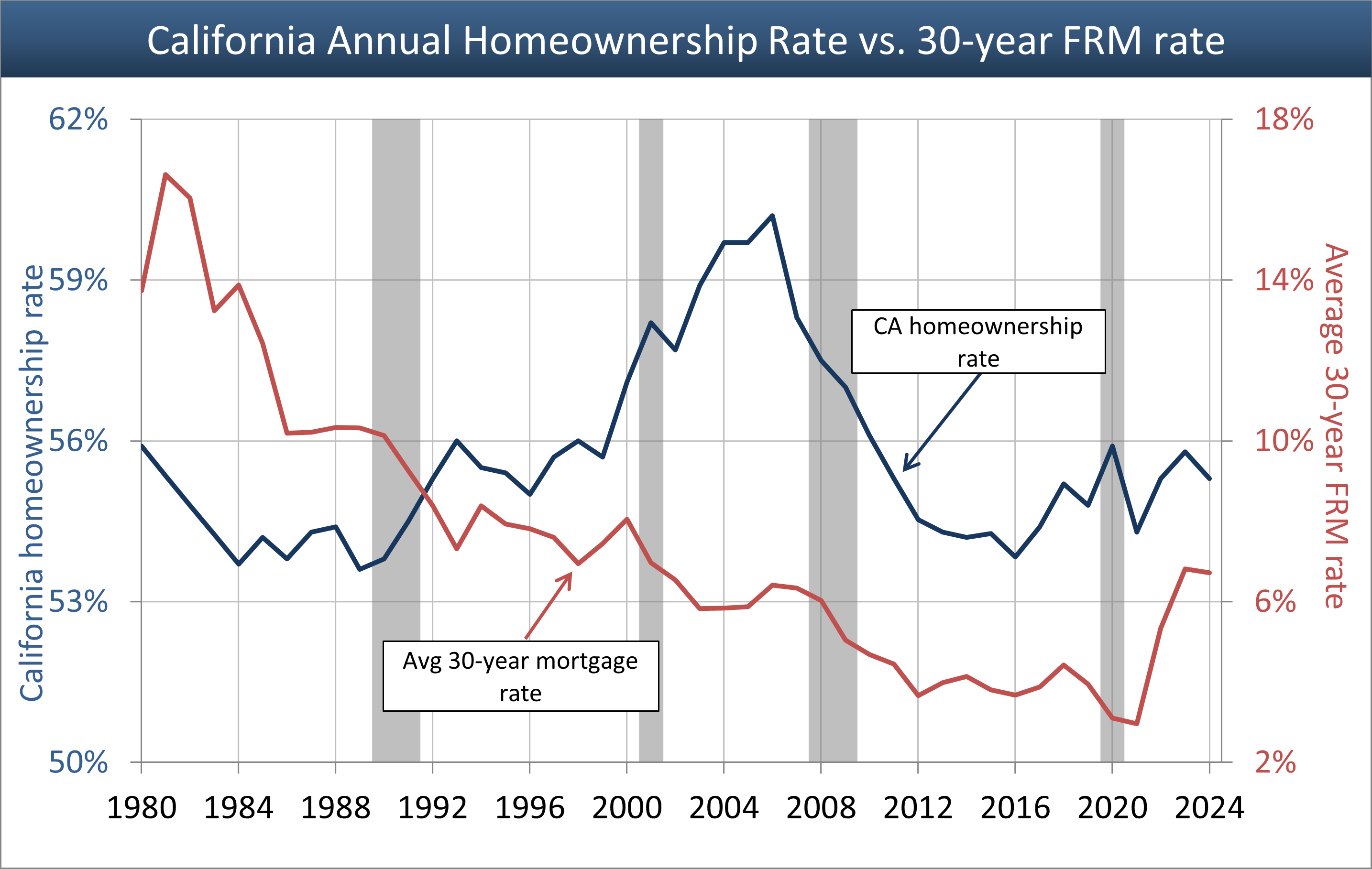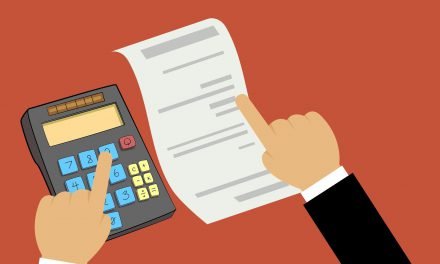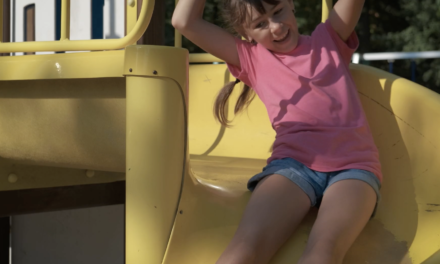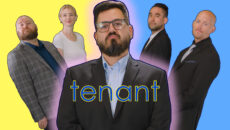Why this matters: California’s homeownership rates, lowered by a return to responsible lending after the Great Recession, have stabilized at a moderate historic level below the rest of the country. As global disruptions and a high FRM rate push hesitant buyers to the sidelines, agents and brokers are observing buyer-clients preferring to wait until for-sale inventories build up significantly, prices bottom and a recovery begins before sales and homeownership rates rise again.
Homeownership steady among debilitating factors
California’s average homeownership rate decreased to 55.3% in 2025. This was down from the homeownership rate of 55.8% experienced in the prior year.
After trending down from its predatory mortgage-induced 60.7% peak in 2006 to its present level near 55%, the homeownership rate has finally stabilized at a normative level for the state.
California’s homeownership rate typically runs around 10 percentage points below the national average, partly due to the flexibility of the state’s more mobile population. Another culprit for California’s low homeownership rate is a lack of residential construction sufficient to support the state’s ever-growing population. This supply-and-demand imbalance cyclically forces homeownership out of reach for many would-be homebuyers, a dynamic which legislators have aggressively addressed for years with little to show in return.
However, as the coming recession settles in, the homeownership gains California has experienced since 2016 appear free from the kind of disruptive loss by foreclosure seen in 2008. Whether our state’s homeownership rate remains near its historical level or declines alongside the global economy remains to be seen.
Post updated August 15, 2025.
Chart 1

Reflects census data taken at the end of each decade
Chart updated 8/15/25
| 2020 | 2006 peak | 1940 low | |
| Homeownership rate | 55.9% | 60.7% | 43.4% |
Chart 2

Chart updated 8/15/25
| 2024 | 2006 peak | 1989: 30-year-low | |
| Average homeownership rate | 55.3% | 60.7% | 53.6% |
Past, present, future
California’s homeownership rate ballooned during the Millennium Boom, only to plunge with the Great Recession and its accompanying foreclosures on 1.1 million homeowners. California’s homeownership rate has finally stabilized around 55%.
California’s homeownership rate is historically around 10 percentage points below the national homeownership rate (at 65.6% nationally as of 2024). This is due to a combination of factors, including the lesser impact the national policy of pushing the “American Dream” of homeownership has had on more mobile and math-conscious Californians.
California’s rate of homeownership has declined dramatically since the 2008 Great Recession, a drop of more than five percentage points since its peak year of 2006. But the Millennium Boom peak was an inflated figure, and 2024’s average homeownership rate around 55% is closer to an historically appropriate level for California.
Understanding the factors which impact California’s low homeownership rate requires an analysis of several economic factors, demonstrated visually through the charts above.
Chart 1: The long view of homeownership
The introduction of Federal Housing Administration (FHA)-insured financing in 1934 was part of a developing push towards homeownership, the commencement of a national housing policy. The FHA allows virtually anyone with a steady income to finance the purchase of a home. Prior to FHA financing, only individuals wealthy enough to qualify with steep 50% down payments had the opportunity to own a home. Sellers frequently supplied the financing with a carryback note for a portion of the price, without which they could not sell.
Much later, Chart 1 shows the evolution of California’s homeownership rate as three factors were introduced:
- 1982: adjustable rate mortgages (ARMs) make their debut in California (state regulated variable interest rate mortgages (VIRs) had already been here for a decade);
- 1986: the federal right to borrow against your home equity as though it were an ATM under the Tax Reform Act of 1986, (Californians had this right from the early 1970s); and
- 1997: the inception of the Internal Revenue Code (IRC) §121 principal residence profit exclusion (capping 30 years of treating a home as an investment).
The easy access to deceptively complex, enticing ARMs in recovery periods allow homebuyers to borrow more than they can with fixed-rate mortgages and more than they can make payments on when the ARM adjusts. And then the incentives provided by the Tax Reform Act of 1986 and the principal residence profit exclusion, pushed the California homeownership rate beyond historical bounds of 55% to 60.7% in 2006.
This high rate of homeownership, quickly attained by mortgage lenders inducing tenants into untenable ownership, proved unsustainable. Homeowners unqualified to handle ARMs once the rate and payments began to reset defaulted, walked and returned to what they knew best – renting.
Related video:
Mortgage Concepts: The birth of the adjustable rate mortgage (ARM)
Chart 2: Recent movements
In a non-recession market, homeownership rates drop as mortgage rates move upward until the Federal Reserve rate cools the economy, as reflected in the rate of homeownership during the late 1950s through the early 1980s. Chart 2 displays the generally unacknowledged converse relationship between the average 30-year fixed rate mortgage (FRM) rate and the homeownership rate (and home price trends) from early 1980 until 2006, at the beginning of the Great Recession.
However, the millennium mortgage financing crisis brought on an unusual tandem drop in both FRM and homeownership rates as ownership then lost its status as part of the American dream in 2008. Today, the homeownership rate has finished stabilizing, correcting the effects of irresponsible lending during the Millennium Boom (not primarily the fault of FHA or Fannie, but the Wall Street bond market which was deregulated and became independent of oversight).
Related article:
Using the yield spread to forecast recessions and recoveries
Just as the 2001 recession’s magic was removing inefficiencies in the economy, fiscal and monetary moves to stimulate the economy post-9/11 fed directly to the Millennium Boom. In the boom, as aided and abetted by financial deregulation, low-tier home prices were artificially driven to a three-fold high.
A new real estate paradigm was prematurely declared in which prices would go up and up forever, in brazen defiance of economic principles. Bond rating agencies, improperly induced by Wall Street bankers, fully endorsed the concept and issued mortgage-backed bonds full of tranches, now sliced and diced for any level of investor risk. To no surprise, this false paradigm came crashing down in 2007, and agents and brokers fell fast into recession and recovery mode.
Apart from the effects of the interest rate cycle of rising and falling rates, the evolving societal mores of the younger first-time buyer generation show an increasing tendency towards renting, rather than owning, one’s shelter. As these new generations are more wary, they are hesitant to repeat the real estate and related mortgage mistakes of the past.
Related article:
Today’s first-time homebuyers are priced out of buying — and also renting
Jobs finally returned to the pre-pandemic 2019 peak in the second half of 2022 – just in time for the next recession.
In California, the pandemic momentum has faded from home prices and buyers’ fear of missing out. In a real estate recession, homebuyers prefer a wait-and-see approach, especially as the latest generations of first-time buyers are more financially literate and less able to borrow large mortgage sums than in years past.
To empower owner and tenant turnover, either the advice of agents to sellers is to lower prices to adjust to recent buyer purchasing power or remove your properties from the market.
Related article:
















Home ownership in California is not going down because this article does not discuss all the methods of home ownership. Home ownership among those who reside in California is going down. However, if you factor in foreign investment and people who buy homes in California who do not live in this state home ownership is up quite a bit. There are very few unclaimed or unowned properties or house in California. If you track sales of homes you will notice those have not declined. I don’t think this is a bubble because as long as foreign investment is coming in to buy homes and real estate the prices will continue to be held high.
13 -48 bp (unch frm 9:30)Dollar/Yen: 110.
Interest rates go down but home ownership goes down anyway?? Property values going up steeply over median income??? What does this tell you?
STOP!!
Bubble time